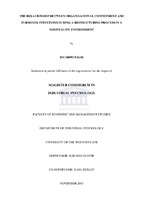| dc.description.abstract | Set against the tenuous relationship between government (public sector), organisations (private sector) and trade unions, employees’ commitment to the success of their respective organisations are of utmost importance. Heugens and Schenk (2004) maintains stakeholders may oppose restructuring efforts as invariably some constituencies will be likely to lose a strategic advantage as a result of drastic change such as a restructure. This reality has resulted in these stakeholders having to find a common ground to ensure economic competitiveness
and longevity of South African organisations. Where this common ground has been elusive, organisations need to find the balance between profitability, environment and its people. According to the King III Report (2009, as cited in Du Plooy & Roodt, 2013) this is referred to as the triple bottom line that is profit, planet and people, which are integrally linked to employee turnover and organisational strategy. Organisational commitment is a key factor to success for organisations in order to obtain and maintain a competitive advantage. Coetzee and Botha (2012) posit that organisations in today’s competitive world require each employee to be committed to the organisation’s objectives and function as an effective team. A competitive advantage is needed to achieve high performance (Nienaber & Masibigiri, 2012). The working world has evolved from one where job security is no longer as prevalent as it used to be. Consequently and understandably, employees’ commitment to their organisations has diminished. Organisations are required to now investigate, understand and put measures in place to grow employee commitment in order have a successful business operation. This study intended to primarily establish whether a relationship exists between organisational commitment and turnover intentions amongst employees in an organisation
undergoing restructuring. Additional variables namely age and tenure were used to establish if these variables have any bearing on levels of organisational commitment. The matter of organisational restructuring may act as an antecedent variable to both organisational commitment as well as turnover intentions. An organisational restructuring is likely to have a negative effect on employees’ organisational commitment. Thus, the affective commitment, continuance commitment and normative commitment of employees were also contrasted with
turnover intentions. Correspondingly, news of an impending restructure may serve to increase employees’ intentions to terminate employment with the organisation.
The sample included 144 respondents (n = 144) from an organisation within the hospitality industry. A method of non-probability, convenience sampling was utilised due to the nature of the study. A Biographical Questionnaire, Organisational Commitment Questionnaire and Turnover Intention Questionnaire were utilised for data collection purposes. The biographical questionnaire aimed to elicit among others important details such as gender, race, age, marital status, qualifications, language preferences and years of service were used for statistical purposes.
Once the information was collected, the Pearson data analysis technique and Analysis of Variance technique were used to establish the relationships and differences between the respective variables under investigation. The results in the study indicate that significant inverse relationships exist between organisational commitment and turnover intentions. Significant differences were found in
organisational commitment based on age and tenure. Similar statistically significant
differences were discovered in turnover intentions according to employees’ age and tenure. Affective, continuance and normative commitment exhibited significant relationships with turnover intentions. The study in closing makes reference to the limitations experienced in the study as well as recommendations for future research especially on organisational commitment and turnover intentions of employees within a restructured or restructuring environment. | en_US |

